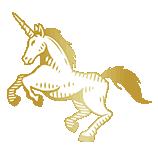Across myth, heraldry and history, the unicorn has long been one of Britain’s most powerful emblems. A creature of legend that’s half horse and half mystery, it represents both purity and ferocity, healing and danger. Its spiralling horn was said to neutralise poison; its spirit was believed untameable, a symbol of something rare and extraordinary.
In imaginatively illustrated medieval bestiaries, unicorns appeared alongside lions, dragons and griffins, but often stood apart as symbols of virtue. Capture of a unicorn, according to legend, was possible only if a maiden lured it to rest its head in her lap; a mixture of innocence and danger that fascinated monarchs and storytellers alike. By the late Middle Ages, the unicorn had become firmly woven into Scottish heraldry, chosen by kings who wanted to project strength, independence and divine right.
A royal emblem with a controversial twist
In 1603, when James VI of Scotland inherited the English throne as James I, he sought a unifying symbol for his new kingdom. Just as the Union Flag later combined the crosses of different nations, his Royal Coat of Arms combined the lion of England with Scotland’s unicorn. But there was a twist: whilst lions roamed free, the unicorns were shown with chains around their necks. Heraldically, this suggested the wild Scottish beast was so powerful it needed restraining; a controversial symbol, depending on your point of view, but one that captured the tension between raw freedom and regal control. Since then, unicorns have adorned countless corners of Britain.

You can spot them carved into stone at Hampton Court, standing guard at the gates and columns of Buckingham Palace, and decorating façades all along St James’s Street. They still appear on royal seals, on historic shops such as James J Fox, and on every British passport, travelling with us around the globe. Today, the unicorn even graces everything from government websites to teapots: proof that this mythical creature is no mere flight of fancy, but part of the nation’s visual DNA.

The unicorn across cultures and modern life
Though its British identity is centuries old, the unicorn carries weight across the world. In Chinese culture, the Qilin, a unicorn-like creature, symbolises prosperity, good fortune and serenity. Often shown wreathed in flames, the Qilin is said to appear only in times of peace and just rule. For many in Asia, the link between unicorns and positive destiny makes the symbol deeply appealing.
In the world of business, “unicorns” describe billion-dollar start-ups, rare companies that have captured the imagination of investors. The metaphor works because unicorns are exceptional, not commonplace; a direct echo of the qualities we attach to fine craftsmanship. Pop culture adds yet another layer: unicorns embody childhood wonder through toys, cartoons and stories, and today are also seen as emblems of self-expression, diversity and imagination.
This kaleidoscope of interpretations makes the unicorn endlessly versatile. Where the lion has long dominated as Britain’s beast of choice, the unicorn is increasingly ready to take its place; an emblem that bridges heritage with modernity, Britishness with global resonance.
What the unicorn signifies for Charatan
Bringing that rich history into Charatan’s world, it becomes clear why Frederick Charatan would think of the unicorn as a fitting logo. Pride and identity are first: the unicorn stands tall, horn forward, echoing the heritage and refinement that define our brand. Strength and wildness follow; the beast is legendary for being untameable, yet heraldry depicts it chained. That tension mirrors fine craftsmanship: unyielding raw material transformed into something exceptional through skill and patience.
Equally, the unicorn’s connotations of rarity, elegance and purity align perfectly with Charatan’s premium cigars and pipe tobacco, products that are crafted for the discerning, not the commonplace. And, as both mythic relic and modern icon, the unicorn bridges past and future, just as Charatan does: honouring more than 160 years of history whilst continually refreshing and evolving.
Our unicorn promises an exceptional experience
Since 1863, when Frederick Charatan began making pipes near the Tower of London, our brand has carried forward a commitment to heritage and craft. From Victorian London pipe-making to today’s global reputation for fine cigars, our journey has always been about adaptation without losing authenticity.
By introducing “a new unicorn for a new era” in 2024, we are not simply adopting a symbol, we are reclaiming one. Our unicorn brings together British heraldry, myth and cultural meaning, all while redefining it as a serious emblem of refinement in the modern age.

Even Sparkles, our towering unicorn mascot at events like InterTabac, helps to show that this is a symbol both timeless and alive, rooted in heritage yet brimming with personality.

In a crowded premium market, standing out matters. The unicorn gives Charatan a narrative that is majestic, historical and contemporary all at once. When you see it on our products, it is more than decoration: it is an invitation to join a legacy that is proud, bold and truly unique.
Long ashes to you all.
3 October 2025
Why a Unicorn Guards the Charatan Legacy
From medieval bestiaries to British passports, the unicorn has always been more than myth. It's a symbol of rarity, strength and imagination, and the Charatan logo for over 160 years.




